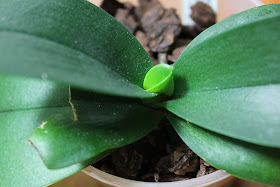I picked up this tiny orchid from the guest shop at the NYBG. I was absolutely charmed by the bright colors and the tiny pot. The bloom spike is several times taller than the plant itself, which was in a pot barely bigger than a dollar coin.
here's the pot with a penny for reference
As soon as I brought the orchid home, I set about getting ready to repot. I soaked the orchid for a while in a tub of water to loosen the roots, and then gently pulled it out of the pot. Even being as gentle as I could, I think I still damaged several leaves. I guess I'll know in a few days if I snapped some leaves if I see them turning yellow.
Surprisingly the orchid was potted up in coarse bark mix. I was expecting to find sphagnum moss, or at least something finer-grained. The roots looked fine, so I did minimal trimming. However, after I spread them out to remove the bark chips, they no longer fit into the original pot. Not having any other pots of similar size, I decided that I would try my hand at mounting the orchid instead. I figured that a pot so small would need watering about as frequently anyway, and with a mount I could avoid needing to distress the roots as often.
And here it is perched on a piece of aquarium driftwood, with a patch of sphagnum moss for moisture. Although I have craft wire, I actually used some old hair ties to attach the orchid to the wood. Perhaps that is a mistake, but it seemed easier at the time. If the hair ties start to rot from the watering, I can supplement with wire later. [edit: I did end up changing over to wire a few days later. It makes a much more stable mount]















































